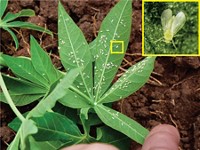Advertisement
Grab your lab coat. Let's get started
Welcome!
Welcome!
Create an account below to get 6 C&EN articles per month, receive newsletters and more - all free.
It seems this is your first time logging in online. Please enter the following information to continue.
As an ACS member you automatically get access to this site. All we need is few more details to create your reading experience.
Not you? Sign in with a different account.
Not you? Sign in with a different account.
ERROR 1
ERROR 1
ERROR 2
ERROR 2
ERROR 2
ERROR 2
ERROR 2
Password and Confirm password must match.
If you have an ACS member number, please enter it here so we can link this account to your membership. (optional)
ERROR 2
ACS values your privacy. By submitting your information, you are gaining access to C&EN and subscribing to our weekly newsletter. We use the information you provide to make your reading experience better, and we will never sell your data to third party members.
Biological Chemistry
Tomato Defense Weapons
Researchers reintroduce herbivore resistance into commercial fruit
by Sarah Everts
November 27, 2012
| A version of this story appeared in
Volume 90, Issue 48
Whiteflies, spider mites, and aphids are among the insects that prey on tomatoes bound for grocery store shelves, devouring the fruit and also spreading viruses that can destroy entire shipments in the $53 billion industry. Researchers in the Netherlands and Germany have now taken a biosynthetic pathway for herbivore-deterring terpenes found in wild tomato varietals and reintroduced the genes into commercial tomato plants via genetic engineering and traditional breeding (Proc. Natl. Acad. Sci. USA., DOI: 10.1073/pnas.1208756109). The plants produce 7-epizingiberene in their stems and leaves but not in their fruit, so tomato flavor should not be altered, says Robert C. Schuurink, a plant biochemist at the University of Amsterdam who led the research. To reintroduce the defensive sesquiterpene into cultivated tomatoes, the team needed to first identify which genes were involved in 7-epizingiberene biosynthesis. A stereoisomer of 7-epizingiberene, α-zingiberene, is found in basil, turmeric, and cardamom plants but does not repel tomato plant herbivores.





Join the conversation
Contact the reporter
Submit a Letter to the Editor for publication
Engage with us on Twitter